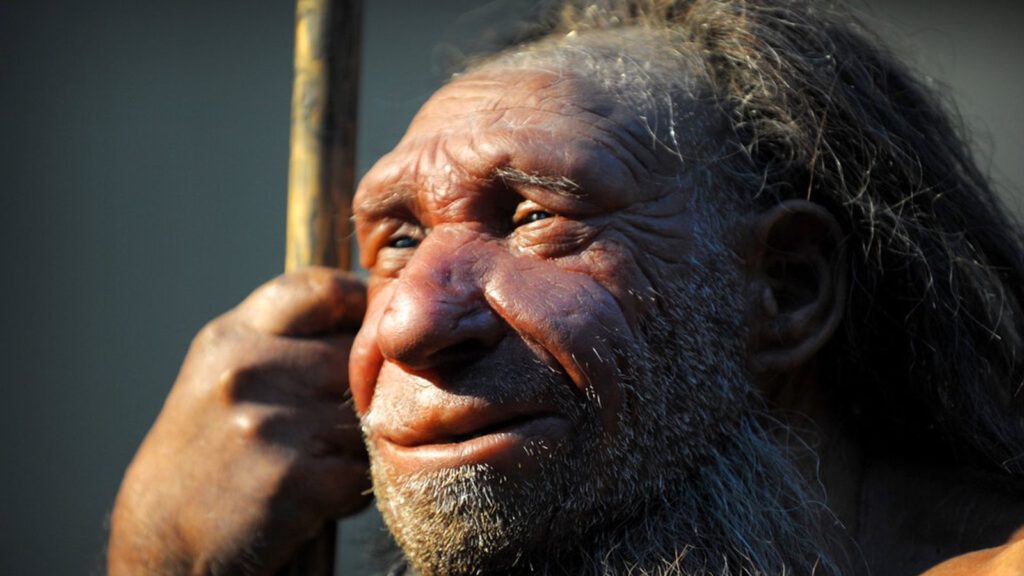DNA inherited from Neanderthals may impact human nose shape, study finds | Science & Tech News

The shape of modern human noses may be partly determined by genetic material inherited from Neanderthals, according to a new study.
Neanderthals were an ancient species who lived in Eurasia until their extinction about 40,000 years ago.
But scientists believe they interbred with homo sapiens – meaning some of their DNA remains in modern-day humans.
Researchers think DNA inherited from Neanderthals may have influenced the shape of modern human faces.
One particular area of interest is the nose, which scientists believe evolved as ancient humans adapted from colder climates after leaving Africa.
A new study – led by researchers from University College London (UCL) – found that a particular gene found in humans, which leads to a taller nose (from top to bottom), may have come from this adaptation.
Co-corresponding author Dr Kaustubh Adhikari, from UCL Genetics, Evolution & Environment and The Open University, said: “In the last 15 years, since the Neanderthal genome has been sequenced, we have been able to learn that our own ancestors apparently interbred with Neanderthals, leaving us with little bits of their DNA.
“Here, we find that some DNA inherited from Neanderthals influences the shape of our faces.
“This could have been helpful to our ancestors, as it has been passed down for thousands of generations.”
Who were the Neanderthals?
With their large noses, strong brows, and relatively short and stocky bodies, the Neanderthals have often been depicted as cavemen-like creatures.
But they, just like us, were humans – though a distinct species called homo neanderthalensis.
Researchers also believe they were rather more complex than their popular image.
They are thought to have been skilled toolmakers who used group tactics to hunt large prey, including mammoths and bison. Neanderthals are also thought to have engaged in art and may have carried out burials of their dead.
They existed from around 400,000 to 40,000 years ago across Europe and southwest and central Asia. This means they would have co-existed with homo sapiens – from which they genetically split at least 500,000 years ago.
Though the cause of their extinction is disputed, competition with homo sapiens, who arrived in Europe around the time of their extinction, as well as climate change, and disease, may have contributed.
However, scientists believe they interbred with homo sapiens, meaning their DNA still remains in modern-day humans.
“As a result, everyone today whose ancestors lived outside Africa at that time has inherited a small but significant amount of Neanderthal DNA, which makes up about two per cent of their genomes,” according to Professor Chris Stringer, from the Natural History Museum.
The study used data from more than 6,000 people across Latin America, of mixed European, Native American and African ancestry.
The UCL-led Candela study recruited from Brazil, Colombia, Chile, Mexico and Peru.
Genetic information from those involved was compared to photographs of their faces, leading scientists to identify 33 new genome regions associated with human face shape.
Read more:
Remains give insight into Neanderthal family life
Neanderthal children may have cut their teeth earlier than modern humans
In one genome region in particular – called ATF3 – the researchers found that many people in their study with Native American ancestry had genetic material in this gene that was inherited from the Neanderthals.
It was also found in those with East Asian ancestry from another group.
Researchers found that this genetic material contributed to increased nasal height.
First author Dr Qing Li, from Fudan University, said: “The gene we have identified here may have been inherited from Neanderthals to help humans adapt to colder climates as our ancestors moved out of Africa.”
Researchers say the study, published in Communications Biology, is the second discovery of DNA from ancient human ancestors, distinct from homo sapiens, affecting our face shape.
The same team discovered in a 2021 paper that a gene influencing lip shape was inherited from the ancient Denisovans.
Recent Posts
- Urban Rest Strengthens UK Footprint
- Clia unveils benefits and events as it opens 2025 membership
- Pullman Hotels & Resorts reveals the ultimate blended travel space – The Transforming Room
- World of Hyatt and Headspace Launch New Series to Help Travelers Find A Good Night’s Sleep
- Influencers signed up as Abta kicks off pre-peaks promotion






Recent Comments